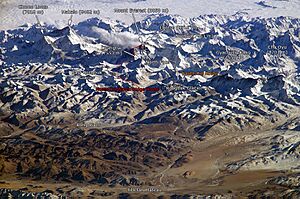Climbing route facts for kids
A climbing route is like a special path that climbers follow to reach the top of a mountain, a big rock, or an icy wall. These paths can be very different in how hard they are. Once a climber starts on a route, it can sometimes be tough to stop or go back down. That's why picking the right route is super important! Books called guidebooks can help a lot. They often show detailed maps and pictures of the routes.
Contents
What is a Climbing Route?
A climbing route is the exact way a climber goes up a mountain, a rock face, or an ice wall. Think of it as a specific trail, but for climbing! These routes can be super easy or incredibly difficult. Choosing the right route is very important for a climber's safety and success.
Early Days of Climbing
Long ago, when people first started mountaineering, they just tried to get to the top however they could. They didn't have much information about the best ways to climb. As more people explored big mountains like those in the Alps during the 1800s, they learned important lessons. They found out that choosing one side of a mountain over another could make all the difference. For example, climbing an eastern face might be much harder or easier than climbing a southwestern ridge.
The Matterhorn Example
A famous example of choosing the right route is the first climb of the Matterhorn mountain. Many climbers tried to reach its top from the southern side, but they kept failing. The rocks on that side sloped downwards, making it very risky.
However, the rocks on the northeastern ridge (the side closest to a town called Zermatt) tilted upwards. This made it a steeper climb, but also a much safer one. This route was eventually used for the first successful ascent of the Matterhorn. It showed how important it was to study the mountain and pick the best path.
Choosing Harder and More Beautiful Routes
After climbers had conquered many mountains using easier routes, they started looking for bigger challenges. They wanted to try harder and more exciting paths.
Climbers also began to care about how a route looked and felt. An easy route that twisted back and forth might not be as appealing as a direct path along a beautiful ridge. Safe routes that allowed for good climbing techniques were preferred over routes with loose rocks or awkward sections.
Naming Climbing Routes
Over time, climbing routes that were especially challenging or needed special skills became linked to the climbers who first completed them. It became a common tradition for the first climber to choose a name for their new route.
For example, "D1" on a rock formation called The Diamond and "The Nose" on El Capitan are famous climbing routes. They are known by the names given by their first climbers.
Finding Out About Routes
If you want to learn about climbing routes, you can find lots of information in special books called climbing guides. These guides describe how difficult a route is, how long it is, and often include pictures and maps. For instance, a book called Fifty Classic Climbs of North America describes many famous climbing routes across North America.
See also
 In Spanish: Vía (escalada) para niños
In Spanish: Vía (escalada) para niños


